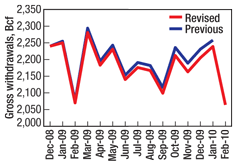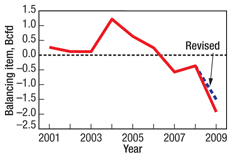|
Vol. 231 No. 6 |

|
|
DAVID MICHAEL COHEN, MANAGING EDITOR
|
EIA’s 2009 gas numbers: Down ... but not by much
When the US Energy Department announced two months ago that planned revisions to the way it estimates US natural gas production would push those estimates downward, industry analysts had a collective “Eureka!” moment.
An article in The Wall Street Journal on April 5 cited several analysts arguing that the previous methodology “has overstated domestic natural-gas output” and “helped push prices to seven-year lows in 2009.” Consequently, natural gas prices would rise (“much higher,” according to one analyst quoted) when the department’s Energy Information Administration (EIA)—which collects the data and publishes it in its monthly “914 report”—made the revisions.
The Journal and other news sources posited that the new methodology would solve two mysteries that have puzzled observers of the US gas market: 1) the growth in US gas output in 2009 despite a 60% decline in the onshore gas-directed rig count, and 2) the widening margin of error between the EIA’s gas supply and demand data.
In its latest 914 report, released April 29, the EIA employed the new methodology not only for its February 2010 gas production data but also to revise its January 2010 data and all 2009 production numbers. Unfortunately for energy analysts, the new numbers do little to solve the gas supply mysteries.
Why the change? Both the old estimation method and the new one use survey data collected from a sample of about 200 to 300 of the top natural gas producing companies to come up with an estimate of total production by state. However, in order to extrapolate from the sample data to total production, the EIA’s previous methodology depended on data that was two to seven years old to estimate the natural gas production of companies that were not included in its survey sample. As a result of this data lag, the agency was unable to fully account for increases or decreases in production among smaller producers. As these small companies have played a bigger role with the explosion of the US gas shale plays in recent years, the consequences of this discrepancy have been magnified. Furthermore, because the data used was so far in the past, the estimation could not respond well to times of rapid change in the industry, such as the present, when new technologies and plays, rapid M&A activity and price volatility keep the gas market in constant flux.
In addition, the old methodology updated the list of surveyed companies—based on their gas production levels—just once a year, in January. This annual update relied on production data that was two years old, and resulted in a change of about 25 operators (roughly 10%) in the sample. This big change in surveyed companies caused a disconnect in the data between December and January, which often exaggerated changes in the production estimate between the two months.
In the new methodology, a simple-ratio method accounts for the production of non-sampled companies by means of a six-month average ratio of the total production to the current sample’s production at some lag time that varies by state. The lag is needed to get complete data for the state from which to calculate the six-month ratio; the lag used is six months for Wyoming, New Mexico and Louisiana, nine months for Texas, 12 months for the federal Gulf of Mexico, and 18 months for Oklahoma. This ratio is then applied to the current reported sample volume to estimate the current total production volume.
The simple-ratio method relies on much more recent historical data than the old method did, resulting in a total production estimate for each state that should respond much better to changes in the industry, especially among small players. In addition, the survey sample is now refreshed every month using monthly data, yielding a change of one or two operators every month rather than 25 or so in January. This change will eliminate errors resulting from large sample changes from year to year.
The verdict. Although the EIA had originally announced that it wouldn’t revise its 2009 gas production numbers using the new methodology until sometime this fall, the agency surprised the industry by making the revisions in its 914 report for April. The new US gas production numbers are lower for each month in 2009 (Fig. 1), with downward revisions being greatest in the federal GOM, Texas and Louisiana.
 |
Fig. 1. Revised versus previous US gas production estimates from the EIA.
|
|
But the fundamental mysteries remain. Average production for 2009 was still 71.7 Bcfd, 1.9% higher than in 2008 (versus 72.2 Bcfd in the previous 2009 estimate). Furthermore, while the “balancing item,” the margin of error between supply and demand, was lowered for 2009 using the new methodology (Fig. 2), it was still unacceptably high for December at more than 7 Bcfd—representing almost 10% of the month’s gas production.
 |
Fig. 2. The EIA balancing item for US natural gas supply and demand, with 2009 revision.
|
|
While the EIA’s new methodology will certainly give operators, traders and analysts better data to work with in making decisions, it seems that it will take more than new data gathering methods to answer the big questions in this increasingly complex and unpredictable market. 
|





